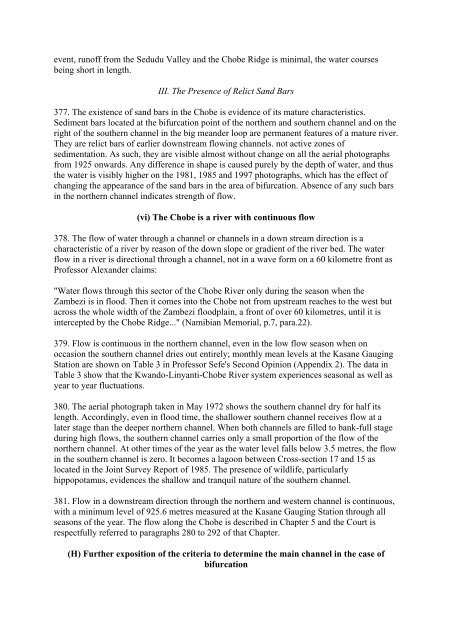botswana/namibia - Cour international de Justice
botswana/namibia - Cour international de Justice
botswana/namibia - Cour international de Justice
You also want an ePaper? Increase the reach of your titles
YUMPU automatically turns print PDFs into web optimized ePapers that Google loves.
event, runoff from the Sedudu Valley and the Chobe Ridge is minimal, the water courses<br />
being short in length.<br />
III. The Presence of Relict Sand Bars<br />
377. The existence of sand bars in the Chobe is evi<strong>de</strong>nce of its mature characteristics.<br />
Sediment bars located at the bifurcation point of the northern and southern channel and on the<br />
right of the southern channel in the big mean<strong>de</strong>r loop are permanent features of a mature river.<br />
They are relict bars of earlier downstream flowing channels. not active zones of<br />
sedimentation. As such, they are visible almost without change on all the aerial photographs<br />
from 1925 onwards. Any difference in shape is caused purely by the <strong>de</strong>pth of water, and thus<br />
the water is visibly higher on the 1981, 1985 and 1997 photographs, which has the effect of<br />
changing the appearance of the sand bars in the area of bifurcation. Absence of any such bars<br />
in the northern channel indicates strength of flow.<br />
(vi) The Chobe is a river with continuous flow<br />
378. The flow of water through a channel or channels in a down stream direction is a<br />
characteristic of a river by reason of the down slope or gradient of the river bed. The water<br />
flow in a river is directional through a channel, not in a wave form on a 60 kilometre front as<br />
Professor Alexan<strong>de</strong>r claims:<br />
"Water flows through this sector of the Chobe River only during the season when the<br />
Zambezi is in flood. Then it comes into the Chobe not from upstream reaches to the west but<br />
across the whole width of the Zambezi floodplain, a front of over 60 kilometres, until it is<br />
intercepted by the Chobe Ridge..." (Namibian Memorial, p.7, para.22).<br />
379. Flow is continuous in the northern channel, even in the low flow season when on<br />
occasion the southern channel dries out entirely; monthly mean levels at the Kasane Gauging<br />
Station are shown on Table 3 in Professor Sefe's Second Opinion (Appendix 2). The data in<br />
Table 3 show that the Kwando-Linyanti-Chobe River system experiences seasonal as well as<br />
year to year fluctuations.<br />
380. The aerial photograph taken in May 1972 shows the southern channel dry for half its<br />
length. Accordingly, even in flood time, the shallower southern channel receives flow at a<br />
later stage than the <strong>de</strong>eper northern channel. When both channels are filled to bank-full stage<br />
during high flows, the southern channel carries only a small proportion of the flow of the<br />
northern channel. At other times of the year as the water level falls below 3.5 metres, the flow<br />
in the southern channel is zero. It becomes a lagoon between Cross-section 17 and 15 as<br />
located in the Joint Survey Report of 1985. The presence of wildlife, particularly<br />
hippopotamus, evi<strong>de</strong>nces the shallow and tranquil nature of the southern channel.<br />
381. Flow in a downstream direction through the northern and western channel is continuous,<br />
with a minimum level of 925.6 metres measured at the Kasane Gauging Station through all<br />
seasons of the year. The flow along the Chobe is <strong>de</strong>scribed in Chapter 5 and the <strong>Cour</strong>t is<br />
respectfully referred to paragraphs 280 to 292 of that Chapter.<br />
(H) Further exposition of the criteria to <strong>de</strong>termine the main channel in the case of<br />
bifurcation

















